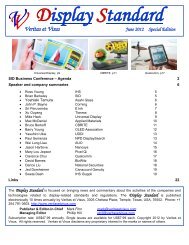Past Editions of “LCD TV Matters” - Veritas et Visus
Past Editions of “LCD TV Matters” - Veritas et Visus
Past Editions of “LCD TV Matters” - Veritas et Visus
You also want an ePaper? Increase the reach of your titles
YUMPU automatically turns print PDFs into web optimized ePapers that Google loves.
LCD <strong>TV</strong> Association LCD <strong>TV</strong> Matters May 2012<br />
Atmel introduces LED driver that enhances LCD <strong>TV</strong> picture quality, eliminates 3D ghosting<br />
Atmel announced a new high-performance family <strong>of</strong> 16-string LED drivers with integrated timing algorithms that<br />
improve picture quality <strong>of</strong> LCD <strong>TV</strong>s by eliminating 3D ghosting and flickering effects. With these capabilities, the<br />
Atmel MSL2164 and Atmel MSL2166 devices are ideal for delivering the most compelling viewing and video<br />
gaming experience via new 3D and 2D scrolling backlight <strong>TV</strong>s.<br />
Featuring highest efficiency power management and backlight control along with multiple dimming modes for 3D,<br />
scanning and zone dimming edge-lit LCD <strong>TV</strong>s, the MSL2164 and MSL2166 devices drive up to 16 parallel strings<br />
<strong>of</strong> LEDs and <strong>of</strong>fer comprehensive system and fault management to support high-performance backlight design.<br />
With this new driver family, high-end <strong>TV</strong> OEMs can deliver high screen resolution and greatly enhance picture<br />
quality using internal lighting timing algorithms that improve the backlight timing accuracy, with higher resolution<br />
vs. other solutions on the mark<strong>et</strong> today. At the same time, since OEMs will be able to choose from smaller form<br />
factor MCUs, such as tinyAVR devices, they can lower their system overhead. Historically, <strong>TV</strong> OEMs have had to<br />
calculate the appropriate param<strong>et</strong>ers to effectively illuminate a desired area in the backlight <strong>of</strong> a display. LED<br />
drivers would generate algorithms to s<strong>et</strong> the appropriate string phase to optimize synchronization <strong>of</strong> the backlight<br />
to the LCD panel. Often, OEMs had to perform additional calculations to adjust the string phrase to ensure that the<br />
backlight was properly synchronized within the frame refresh. The MSL2164 and the MSL2166, with multiple pulse<br />
width modulation (PWM) modes—including forward, inverse, trailing and center—reduce design complexity<br />
because the timing algorithms are integrated into the devices. This ensures that the backlight is illuminated at the<br />
most optimal moment, when all <strong>of</strong> the LCD pixels have s<strong>et</strong>tled. http://www.atmel.com<br />
DisplaySearch reports LCD <strong>TV</strong> shipment growth to improve in 2012 driven by 40-inch and larger sizes<br />
Consumer demand for <strong>TV</strong>s has been s<strong>of</strong>ter than expected in 2011, but showing signs <strong>of</strong> improvement late in the<br />
year. However, inventory pressure plagued the industry through much <strong>of</strong> early 2011 and led to a sharp reduction<br />
in shipments to r<strong>et</strong>ailers. The result is that global <strong>TV</strong> unit shipments are expected to rise only 0.1% in 2011.<br />
According to the latest forecast released in the NPD DisplaySearch Advanced Quarterly Global <strong>TV</strong> Shipment and<br />
Forecast Report, growth is expected to improve in 2012, rising 2% to 254 million units. Flat panel <strong>TV</strong> continues to<br />
grow, but at a more gradual pace <strong>of</strong> 2-4% per year as the rapid transition from CRT to LCD and plasma nears an<br />
end. LCD <strong>TV</strong> continues to be the dominant technology on a unit and revenue basis, and in fact seems likely<br />
capture even more mark<strong>et</strong> share due to a weaker outlook for plasma <strong>TV</strong> going forward. As LCD narrows the<br />
pricing gap with plasma at many sizes, the demand for plasma has fallen; NPD DisplaySearch expects this to<br />
continue and has reduced its forecast for plasma <strong>TV</strong>.<br />
Large <strong>TV</strong> sizes also continue to show strong growth, with shipments <strong>of</strong> 40-inch+ and larger s<strong>et</strong>s expected to grow<br />
12% in 2012 while






